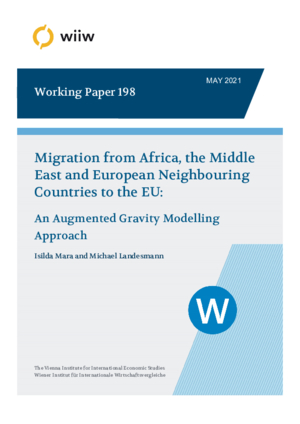Migration from Africa, the Middle East and European Neighbouring Countries to the EU: An Augmented Gravity Modelling Approach
Michael Landesmann and Isilda Mara
wiiw Working Paper No. 198, May 2021
41 pages including 3 Tables and 23 Figure
The South-North migration corridor, i.e. migration flows to the EU from Africa, the Middle East and EU neighbouring countries in the East, have overtaken the East-West migration corridor, i.e. migration flows from Central and East European countries to the EU15 and the European Free Trade Association (EFTA). This is likely to dominate migration flows into the EU+EFTA over the coming decades. This paper applies a gravity modelling approach to analyse patterns and drivers of the South-North migration corridor over the period 1995-2020 and explores bilateral mobility patterns from 75 sending countries in Africa, the Middle East and other EU neighbours to the EU28 and EFTA countries. The study finds that income gaps, diverging demographic trends, institutional and governance features and persisting political instability, but also higher climate risks in the neighbouring regions of the EU, are fuelling migration flows along the South-North corridor and will most likely continue to do so.
Keywords: Migration, Africa, Middle East, Eastern EU partnership countries, migration to EU, demographic developments, refugees, migration policies, gravity modelling, climate risks
JEL classification: F22, J110, J61, O150
Countries covered: Africa, CEE, European Union, Middle East, New EU Member States, Wider Europe, EU neighbouring countries
Research Areas: Labour, Migration and Income Distribution
